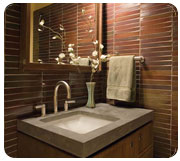
Color and texture are revitalizing residential designs today. A private home in Cambridge, MA, features colorful tiles of various shapes and sizes in rooms throughout the 4,000-square-foot space, including this bathroom. Designer: Todd Tsiang Tile Manufacturer: Trikeenan Tileworks, Inc., Keene, NH
Long Associated with high-end quality designs, stone and tile are now playing an even greater role in contemporary residential and commercial projects. Consumers are seeking materials with rich colors and texture - products that will really create a sense of depth and add character to a space. And as a result of these growing demands, tile manufacturers are devoting endless hours behind the scenes to launch sophisticated and elegant product lines to meet these design objectives.
Neutral tones remain popular, but are being used as a canvas or backdrop rather then the central focus of a design. Consumers are choosing stone and tile products that spark interest and bring energy to a room. They are incorporating more decorative elements into their designs - creating a more personalized effect. Whether it is a residential interior or hotel lobby, decorative materials such as glass, metal, hand-painted ceramic or customized stone pieces are enhancing spaces with splashes of color and movement. Consumers want a more decorative environment for their living spaces as well as for the places where they shop, dine, work or vacation.
The use of bright or bold colors - either as an accent or to span an entire wall or floor - can draw emotion as well as set the tone of a space. Additionally, rough textures or surfaces with a smooth sheen can also create specific atmospheres and moods.
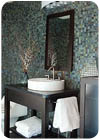
For a half bath on the first floor, richer and bolder colors were selected to spice up the space. “The homeowner entertains a lot, and he wanted to make it a more dramatic nighttime bathroom,†said Tsiang, adding that the tile was complemented by a limestone sink top. Stone Supplier: Kallista
Planes of Color
In just one example, each room of a private residence in Cambridge, MA, was brought to life with a colorful palette of ceramic tile. The varying shapes, shades and textures of the tile pieces used throughout the rooms of the 4,000-square-foot home create a rich feel of elegance as well as a place of comfort and relaxation. The designer and homeowner worked along with the tile manufacturer to thoughtfully hand pick each of the pieces - making for a very personalized design.“It's a 1950s modern house,†said designer Todd Tsiang, explaining that while the home remained contemporary, the client wanted the interior to be warm and inviting. “A lot of the design aesthetic was to use surfaces as planes. The tiles were chosen to be a plane of color - that's why there aren't any borders or moldings. There's not tile on every wall, but there is always a solid wall [of color]. Different surfaces have different finishes, but one finish is used on an entire surface.â€
The designer went on to explain that the homeowner is an avid pottery collector, and he selected tiles that reminded him of the pottery that he has collected from places around the world. “He also liked the variation of color in the tiles,†said Tsiang. “Even though each tile is one color, there is a lot of variation within it creating movement.â€
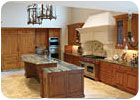
For the redesign of a 500-square-foot kitchen in a private residence located in Long Grove, IL, Verde Amazonia granite was chosen for the countertops, while limestone was employed for the floor. Further adding to the elegance of the space is a beautifully crafted decorative backsplash made of marble, onyx, crackle glaze and vintage broken ceramic tiles, and gold Byzantine glass. The mosaic inset is complemented by 3- x 6-inch tumbled marble tiles, which were employed for the remainder of the backsplash. Designer: ESL Design Group, Chicago, IL; Mosaic Designer, Fabricator & Installer: Studio E, Chicago, IL; Stone Supplier: Materials Marketing, Chicago, IL (marble backsplash tile, limestone range hood)
Another interesting aspect of this residential project was that it was chosen to be highlighted during the 2005/2006 season of “This Old House.†“I've been working with the homeowner for four years,†said Tsiang. “He submitted the project to 'This Old House,' and about six months before [construction began], it was accepted. Once they got involved, we selected the material. They knew Trikeenan, and introduced us.â€
While each of the rooms throughout the house features varying color schemes, the shades are complementary - unifying the design and creating a warm inviting atmosphere. The designer and homeowner gave careful consideration to the form and function of each space before deciding on the color, shape and texture of the tile that would be employed.
“The master bedroom is very personal to the homeowner,†explained Tsiang. “The colors in the bath are closest to the colors in his pottery. The tiles have a matte finish.†Tiny rectangular tiles of muted shades of brown, teal and green cover the shower walls, while square mosaic tiles in the same colors form the ceiling. Additionally, the rectangular tiles were used to clad the front of the luxurious Jacuzzi tub as well as the bathroom walls. “
The second floor is more neutral tones and beiges,†said the designer. He explained that the homeowner wanted a soothing palette that would create a comforting atmosphere for his guests. As a result, a soft blend of earth-toned colors was chosen for the guest bath design.
For a half bath on the first floor, richer and bolder colors were selected to spice up the space. “The homeowner entertains a lot, and he wanted to make it a more dramatic nighttime bathroom,†said Tsiang. “The tiles worked with the woods.†The walls are comprised of tiles that resemble the look of brick in deep shades of red and brown.
Because the homeowner enjoys entertaining, the home includes a bar area, which features a decorative tile backsplash, which was from Trikeenan's “Glass Windows†collection. “It's very fun,†said the designer, explaining that he first discovered the tile in one of the company's brochures. “We liked the movement in the glass. We also selected it because it [reflects] water and waves. We picked the colors and shapes.â€
Complementing the glass backsplash is a bartop fabricated from Brazilian Gray Cleft slate - supplied by Gerrity Stone of Woburn, MA. And although the supplier expressed some concerns about using the porous material for a bartop, the homeowner was adamant about his decision. He even performed some of his own “tests†on a 12- x 12-inch sample to see if staining would occur. In the end, he was satisfied with his results, and proceeded with the slate top, which was sealed, according to Tsiang.
The renovation of the Cambridge residence was finished in about seven months. “'This Old House' is much more concentrated,†said the designer. “The homeowner had to move out. Normally a project like this would take over a year to complete.â€
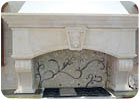
The entire backsplash, which features a detailed vine motif, was made in one section and took about two weeks to complete. Additionally, a large dimensional limestone sculpted hood frames the decorative backsplash.
A Decorative Accent
And while an extensive use of colorful tile can certainly liven up an interior, decorative pieces can also achieve similar effects when used as accents. Such was the case for the redesign of a 500-square-foot kitchen in a private residence located in Long Grove, IL. While function was a primary requirement, the homeowner also wanted to use material that was warm and inviting.“The goal of the family was one of function,†said designer Elizabeth Lisk of ESL Design Group in Chicago. “[The homeowner] loves to cook. She has lots of brothers and sisters always coming over. The kitchen is a place to cook, visit and entertain all in one room. The island is quite large - perfect for prepping food on the inner-lower countertop while visiting with guests sitting across from you at the higher portion of the island.â€
According to the designer, the original look of the home was slightly modern. “It has transitioned into more of an Old World style,†she said. “There is elegance, while keeping it casual and comfortable.â€
Contributing to the relaxed yet classy design of the kitchen are countertops fabricated from Verde Amazonia granite and a limestone floor. Further adding to the elegance of the space is a beautifully crafted decorative backsplash made of marble, onyx, crackle glaze and vintage broken ceramic tiles, and gold Byzantine glass. The mosaic inset is complemented by 3- x 6-inch tumbled marble tiles, which were employed for the remainder of the backsplash.
“The homeowner found a backsplash idea in the Merchandise Mart that she liked, and she wanted to do something similar to it,†explained Lisk. “When researching the artist of the backsplash, I was directed to Evan Glassman of Studio E, who designed it.â€

The floor of Godiva Chocolatier at the Circle Center Mall in Indianapolis, IN, is comprised of Sicis polished Azul Marlena marble mosaic tile. “That was the tile that we all fell in love with,†said Creative Director Kathi McWilliams, explaining that the coloring of the marble is a blend of mocha and gray. Designer: JGA, Southfield, MI; Stone Supplier: Virginia Tile
Glassman explained that when designing decorative pieces such as the backsplash, he pulls from an assortment of tile samples and stone varieties that he keeps on hand. “I put together some samples to show [the homeowner],†he said. “These clients knew what they wanted. It was a matter of trying to get it on paper first. We customized it to work with the colors in their kitchen.â€
The entire backsplash, which features a detailed vine motif, was made in one section and took about two weeks to complete. “We installed the whole piece without the Byzantine glass because the gauge was less than 1/4 inch,†explained Glassman, adding that the rest of the stone and tile pieces were mesh-mounted at his studio.
Installation of the piece was completed in one day. “We were in and out,†said the mosaic designer. “We had to do a little retro fit on top.â€
Both the designer and homeowner were extremely pleased with the end result. “Evan created some really great details with vines running through it,†said Lisk. “It's a nice mix [of material]. The backsplash marries the countertops with the cabinetry perfectly.â€
Additionally, a large dimensional limestone sculpted hood frames the decorative backsplash. “It was a really nice focal point,†said Glassman. “It's a grand kitchen - about 16 to 18 feet high.â€
Overall, Glassman was also happy with the project. “I really enjoyed this project because the kitchen had a nice aesthetic, and Elizabeth was great to work with and very helpful,†he said. “They have some beautiful elements to that house. It works well, and is very functional.â€
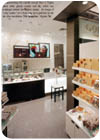
Complementing the marble mosaic floor is Tagina Siena white glazed crackle wall tile, which was employed behind the dessert station. An image of “Lady Godiva†on a horse was set in gold leaf on the tile after installation. Tile Supplier: Virginia Tile
A Contemporary Twist
Homeowners are not the only ones, however, who are looking for materials that reflect their personalities and interests. When redesigning retail outlets for Godiva Chocolatier nationwide, the design team at JGA of Southfield, MI, desired materials that would be representative of the chocolate manufacturer's Belgium heritage. The company was looking to present a fresh image, and after some consideration, the design team found marble mosaic and gold-leafed subway tiles to be the most suitable materials to meet the design requirements.“Godiva decided that it needed to update its brand,†said Kathi McWilliams, Creative Director, of JGA. “Like most retailers, they wanted to get to younger consumers, and broaden their customer base. Also, they wanted to move from [the concept of] gift giving to more self indulgence.â€
The designer explained that JGA was contracted to develop prototypes for about three or four Godiva retail stores, including one at Circle Center Mall in Indianapolis, IN. The rollout globally is being managed by the Godiva team, with the assistance of outside contractors.
“We had done research on historic references of Belgium heritage,†explained McWilliams. “We wanted to move toward a contemporary concept, while still honoring Godiva's heritage.â€
In addition to choosing an appropriate material palette, it was also important to create a more approachable inviting environment for the stores. Godiva no longer wanted to be viewed as only a source for boxed candy. The company wants to be thought of as a place where consumers can come to indulge in a chocolate truffle or chocolate-dipped strawberry.
As a result of Godiva's new philosophy and brand image, stores now consist of three shops. This includes an area focusing on handmade individual pieces of chocolate and custom-made beverages; another area where a series of seasonal and special product stages - combined with flexible modularity - allow for the bulk and assortment of food, seasonal and giftable products; and a third area where traditional Godiva gift items are located.
“It's a brighter and much more active environment,†said McWilliams. The designer explained that in researching Belgium history, they discovered that mosaic floors were commonly seen in historic buildings. “We also found that when you use tiny mosaics, they absolutely sparkle,†she said. “People are drawn to the store. It is working very well by creating a modern allure.â€
Once the decision was made to use mosaic tile for the floor of the store, the hunt for the material began. After viewing several different options, Sicis polished Azul Marlena marble mosaic tile - supplied by Virginia Tile - was chosen for the project. “That was the tile that we all fell in love with,†said McWilliams, explaining that the coloring of the marble is a blend of mocha and gray. The mosaic pieces were about 1/2 x 1/2 inch in size and mesh mounted. “What I discovered about this tile is that every piece isn't flush, and it is those little angles that really make it sparkle,†said the designer.
Complementing the marble mosaic floor is Tagina Siena white glazed crackle wall tile, which was employed behind the dessert station. The material was also supplied by Virginia Tile. An image of “Lady Godiva†on a horse was set in gold leaf on the tile after installation. “The brick-patterned tile created strong horizontal bands,†said McWilliams. “All the elements that we used were old, and we brought them into a more modern context.â€
Further enhancing the look of the space is a countertop made of Materra marble with a polished finish, which was supplied by Dwyer, Marble & Stone. This too reflected the use of Carrara marble in Old World Europe, according to the designer. “We made an expensive choice, but we decided that when looking for signature items, the materials were very important, so we value engineered [elsewhere],†said McWilliams.
In total, the completion of the 800-square-foot Godiva store at Circle Center Mall took approximately nine months to complete. “It took a little longer than usual, because we spent a lot of time on the upfront process - understanding the design and where they wanted to go,†explained McWilliams. “[Godiva] was very pleased with the installation. It already won two design awards, and most importantly, it is really bringing something to their bottom line. Not only are they happy with the look, but more customers are coming in to browse. Before it was a staid environment. Now the entrance is much wider and less intimidating.â€